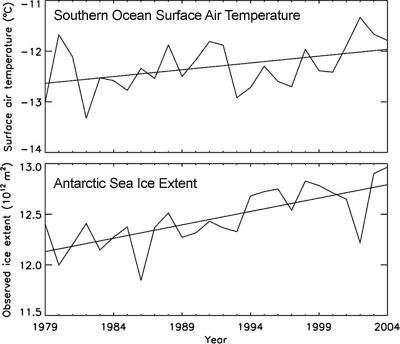Watts Up With That's ignorance regarding Antarctic sea ice
Posted on 9 March 2010 by John Cook
In recent weeks, the Watts Up With That blog has focused several times on Antarctic sea ice. Specifically, Steven Goddard mentions that Antarctic sea ice has increased over recent decades, speculating this is probably due to cooling around Antarctica. In one post, he comments that "sea ice extent has been increasing over time around Antarctica – this is consistent with the idea that temperatures are cooling". In another post, he repeats this theme: "Antarctica is cooling and sea ice is increasing (makes sense – ice is associated with cold)". If his intent is to accurately describe why Antarctic sea ice is increasing, he would be better served first checking what observations and peer-reviewed research have to say on the matter.
The most common misconception regarding Antarctic sea ice is that sea ice is increasing because it's cooling around Antarctica. Goddard commits this error on several occasions. The reality is the Southern Ocean surrounding Antarctica has shown strong warming over the same period that sea ice has been increasing. Globally from 1955 to 1995, oceans have been warming at 0.1°C per decade. In contrast, the Southern Ocean (specifically the region where Antarctic sea ice forms) has been warming at 0.17°C per decade. Not only is the Southern Ocean warming, it's warming faster than the global trend.

Figure 3: Surface air temperature over the ice-covered areas of the Southern Ocean (top). Sea ice extent, observed by satellite (bottom). (Zhang 2007)
If the Southern Ocean is warming, why is sea ice increasing? There are several contributing factors. One is the drop in ozone levels over Antarctica. The hole in the ozone layer above the South Pole has caused cooling in the stratosphere (Gillet 2003). A side-effect is a strengthening of the cyclonic winds that circle the Antarctic continent (Thompson 2002). The wind pushes sea ice around, creating areas of open water known as polynyas. More polynyas leads to increased sea ice production (Turner 2009).
Another contributor is changes in ocean circulation. The Southern Ocean consists of a layer of cold water near the surface and a layer of warmer water below. Water from the warmer layer rises up to the surface, melting sea ice. However, as air temperatures warm, the amount of rain and snowfall also increases. This freshens the surface waters, leading to a surface layer less dense than the saltier, warmer water below. The layers become more stratified and mix less. Less heat is transported upwards from the deeper, warmer layer. Hence less sea ice is melted (Zhang 2007).
Antarctic sea ice is complex and counter-intuitive. Despite warming waters, complicated factors unique to the Antarctic region have combined to increase sea ice production. The simplistic interpretation that it's caused by cooling is false. It's unfortunate that Steven Goddard has publicly speculated on why Antarctic sea ice is increasing without fully investigating what observations and research have found. The result is that many readers at Watts Up With That have been misled on the true and fascinating nature of Antarctic sea ice.
Note to regular readers: yes, I know I'm rehashing content from Antarctic is gaining ice. Sometimes a little repetition is required for the message to sink in.































 Arguments
Arguments






























Weather and ocean cycles cause the heat within our climate system to slosh around in chaotic ways. But the total heat content of our planet continues to increase because of the energy imbalance imposed by increased greenhouse gases.